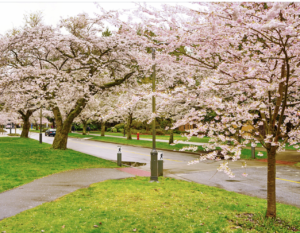Anúncios
An ambitious rewilding initiative is trying to save Rio de Janeiro’s ancient jungle from colonial crops.
Fumes beneath a concrete bridge suffocate me one minute. Minutes later, I’m sweaty and sticky from woodland respiration. That’s not true in every metropolis, particularly one with over six million people.
Rio de Janeiro is famous for its beaches, football, and Carnival, but few realize that it has the world’s biggest urban forest, the Tijuca.
Anúncios
Tijuca is unusual woodland. The 40 sq km Tijuca Forest is part of the Atlantic Forest, which formerly stretched 1,000,000 sq km of Brazilian coastline. It was protected in 1861, a decade before the first national park in the US. The 16th-century European colonists who settled Brazil destroyed 15% of the Atlantic Forest with sugarcane and coffee crops and logging.
In Rio de Janeiro, the loss of Atlantic Forest over 200 years almost killed the new colony. Drought was looming as city rivers dried up. Emperor Peter II suggested replanting the woodland in the 19th century. Enslaved Africans were made to grow over 100,000 trees in the 1860s when farmers and city people on forest property were expropriated. However, few woodland animals returned.
Anúncios
In 1967, the Tijuca forest was named a national park with three non-contiguous sectors: west of the city center, Carioca, where the Cristo Redentor monument resides, and Pedra Bonita and Gávea mountains overlooking the ocean. More than 3.5 million people visit Tijuca National Park yearly, making it the country’s most visited.
“Picture in your mind just for a second Rio without the forest, just the bare mountains and the seas – Rio would not be the wonderful city anymore,” said Fernando Fernandez, a Federal University of Rio de Janeiro ecology professor and Project Refauna co-founder.
Brazil’s second-largest city relies on the Tijuca forest for freshwater and temperature regulation. Fernandez says the forest is unhealthy.
Hiking in Tijuca National Park shows a healthy forest. Hikes to more than 30 waterfalls and up prominent mountains like Pedra da Gávea and Pedra Bonita show rich vegetation with hanging vines, enormous jackfruit splattered on the ground, and charming capuchin monkeys gathering bananas.
What to do and where:
Public transit, bikes, and taxi/Uber can take visitors from Rio’s South Zone to all three Tijuca National Park districts.
Tijuca Forest: Explore waterfalls, coffee plantation ruins, Tijuca Peak, and Project Refauna’s imported species.
Pedra Bonita and Pedra da Gávea: Climb Rio’s most popular mountains for city views.
–Carioca Mountain: Hike from 19th-century castle Parque Lage to see Cristo Redentor.
Without them, the forest won’t collect enough carbon to delay climate change and become “a disturbed forest that is a mess of trees of every size”.
Tall trees should interweave above to create a healthy forest canopy, but they don’t. “What tells you the Atlantic Forest is mature is that if you are standing in the forest, you can see another person 50 or 100m from you,” stated.
Because the forest is depleted of seed-spreading animals, Tijuca’s lofty trees are struggling to spread. “If you don’t have the animals, you don’t have the trees,” said Project Refauna researcher Catharina Kreischer.
Kreischer noted that colorful, tasty fruit attracts hungry animals, who digest the seeds and excrete them elsewhere, spreading the plant species over the forest. Many seed-spreading animals left this forest after it was cut and never returned. So Project Refauna is bringing animals back to Tijuca since a forest isn’t simply trees.
Project Refauna starts modestly instead of “rewilding” forests with headline-grabbing predators like wolves or bears. “Most people that think about introducing species think about endangered species,” he stated. “With Refauna, we purposely work with non-endangered species [that relocated elsewhere when the forest was cleared].”
Jaguars, tapirs, and peccaries were among 33 large- and medium-sized species in Tijuca Forest, but just 11 survive. Project Refauna might return some of these creatures, but many need a bigger hunting range or are too hazardous to be let into a metropolis. Instead, it’s restoring forest-endemic, easy-to-work-with species that flourish elsewhere in Brazil.
In 2009, Project Refauna reintroduced red-rumped agoutis, a cat-sized rodent that had been extinct in Tijuca Forest but was still roaming the city. I visited 15 years later and saw the project’s effect.
Kreischer and I strolled into the park (free) after getting off the 301 bus at Praça Afonso Viseu, which is one of its major gates. We stopped along the main road to pick up a brown, apple-sized arara nut beneath a large tree. “When I started working at Refauna, I could see a lot more seeds, especially on the main road, than I do now,” said Kresicher, who pulled up her pant leg to show her agouti ankle tattoo. “I observe less decaying fruits and seeds in the forest now. This shows that the agoutis are establishing themselves and performing their duty.”
Titan, a massive yellow-footed tortoise delivered to the park by Project Refauna in 2020, was reached after walking over clay pathways beyond the Cascatinha Taunay waterfall. Titan had crimson murder in his eyes as I approached his cage to snap a picture, and my pulse hammered faster than I’d want for such a slow-moving menace. Titan’s aggressive attitude forced him to be removed from his fellow tortoises, destroying his lineage, but there was more terrible news.
Kreischer said tortoises, like agoutis, are great seed dispersers since they consume nearly anything and defecate distant from the parent plant due to their sluggish digestive processes. Tortoises, unlike agoutis, have struggled in Tijuca Forest, with just 30 of 56 introduced surviving due to city dogs that infiltrate the park.
Kreischer took me to Project Refauna’s headquarters to see two researchers installing camera traps to capture domestic dogs who dig up and consume tortoise eggs.
Howler monkeys, another Project Refauna reintroduction, also failed. A century after the primates disappeared from the park, the organization returned them in 2015. Only two of the seven reintroduced to the park survive. The others perished from yellow fever.
When asked whether the project was progressing well, Fernandez said honestly, “No.”
The loss of the howler monkeys and tortoises was devastating, and the organization has struggled to raise funds. Fernandez will not quit.
Project Refauna reintroduced vaccinated howler monkeys in January and is now working on the blue and yellow macaw. The goal is to reach ocelots, a medium-sized spotted wild cat, the biggest predator that thrived here before Rio became a city and could survive in a forest this size again.
“This is a decades-long project,” Fernandez stated.
Since saving a forest is slow, Fernandez and Kreischer suggest visiting the park as I did.
Joel Balsam Kreischer and Fernandez think visitors to the park are one of the finest ways to aid the Tijuca. Joel Balsam photoJoel Balsam, Kreischer, and Fernandez suggest that visitation to the Tijuca is a key approach to aid the park. Joel Balsam photo
Hiking in the forest, enjoying its vistas, and learning about its flora and wildlife reminds people that Rio’s existence depends on this forest. “The more people visit this forest, the more people enjoy this forest, the more protected the forest will be,” he stated.






